| Description | Participants | Summaries | Products |
|---|
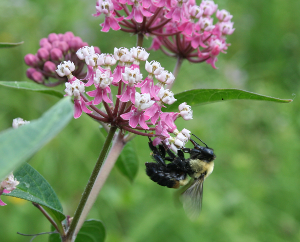
|
| Credit Nicole Rafferty |
Archived NIMBioS Working Group
Biotic Interactions
Topic: When are biotic interactions necessary to model species distributions?
Organizers:
William Godsoe (School of Biological Sciences, Univ. of Canterbury, Christchurch, New Zealand)
Robert D. Holt (Univ. of Florida, Gainesville)
Meeting dates: February 1-4, 2013; September 23-26, 2013; May 12-16, 2014; May 11-15, 2015
Objectives:
One of the fundamental challenges in ecology is to predict species' geographic distributions. A strong understanding of this basic question is necessary to make predictions about the distribution of biodiversity and biosecurity threats. Though large datasets are now available to predict species distributions, existing models are limited by our poor understanding of how the distribution of one species is affected by its interactions with other organisms.
This working group will address this substantial ambiguity by formally linking ecological theory on species interactions to empirical species' distribution models. We will investigate the relative importance of species interactions and the abiotic environment at large spatial scales, determine whether omitting some species interactions (e.g. predation) produces poorer inferences than omitting other interactions (e.g. competition) and identify the conditions under which we must disentangle the effects of species interactions from dispersal and population stochasticity.
Specific objectives:
- Test when species interactions matter at large biogeographic scales. To do this, we will identify the conditions under which the probability that a species is present converges on the probability that the abiotic environment is suitable at large spatial scales.
- Specify the species interaction most likely to induce biases when predicting species' distributions. To do this we will test whether omitting some species interactions (say predation) induce more bias in Species' Distribution Models (SDMs) than omissions of other species interactions (say competition).
- Test the bias due to for synergistic effects of species interactions, dispersal, history and stochasticity. We will synthesize the conditions under which species interactions act synergistically with other ecological factors to bias SDMs.

Meeting Summaries
| Mtg # | Dates | Agenda | Summary | Photo | Evaluation |
|---|---|---|---|---|---|
| 1 | Feb 1-4, 2013 | Link | Link | Report | |
| 2 | Sep 23-26, 2013 | Link | Link | ||
| 3 | May 12-16, 2014 | Link | Link | ||
| 4 | May 11-15, 2015 | Link | Link |
Meeting 1 Summary. The stated goal of our working group is to develop an intuitive and quantitatively rich understanding of when information on species interactions is necessary to model species distributions. During our first meeting we surveyed available statistical and mathematical methods to incorporate species interactions into inferences of species' distributions, discussed potential methodological advancements, and further examined more broadly the mutual interplay of species coexistence theory and range theory, and the overlap of both these with empirical species' distributional modeling.
Meeting 2 Summary. During our second meeting, we tested scientists' ability to learn about the influence of biotic interactions on species' distributions using simulated datasets. To accomplish this, we have used relatively simple models focusing solely on species interactions and more sophisticated models that also include dispersal and environmental fluctuations. We used mathematical modeling to compare many different types of species interactions that can potentially shape species' distributions notably predation, mutualism and competition. We then applied these mathematical ideas to living species that would be difficult to study in the absence of theory, for example, to study the role of fish mediated dispersal in shaping the distribution of threatened mollusk species.
Meeting 3 Summary. During the third meeting, we tested scientists' ability to learn about the influence of biotic interactions on species' distributions using simulated datasets. Ecologists have used mathematics to study the effects of one species on another, such as predation, for decades. In the past, it has been hard to connect this work to empirical studies of species' distributions. Our most important insight: theories about species interactions that result in elimination of a species can provide powerful guidance on where a species will be present. We have used this insight to derive new mathematical results, design simulations, and review and re-interpret available theory. Our next goal is to publish important components of this work.
Meeting 4 Summary. Our working group has tested scientist's ability to learn about the influence of biotic interactions on species' distributions using simulated datasets. Ecologists have used mathematics to study the effects of one species on another, such as predation, for decades. In the past it has been hard to connect this work to empirical studies of species' distributions. Our most important insight has been that theory describing when species interactions can eliminate one species can provide powerful guidance on where a species will be present. We have used this insight to derive new mathematical results, simulate interactions, and review and re-interpret available theory.
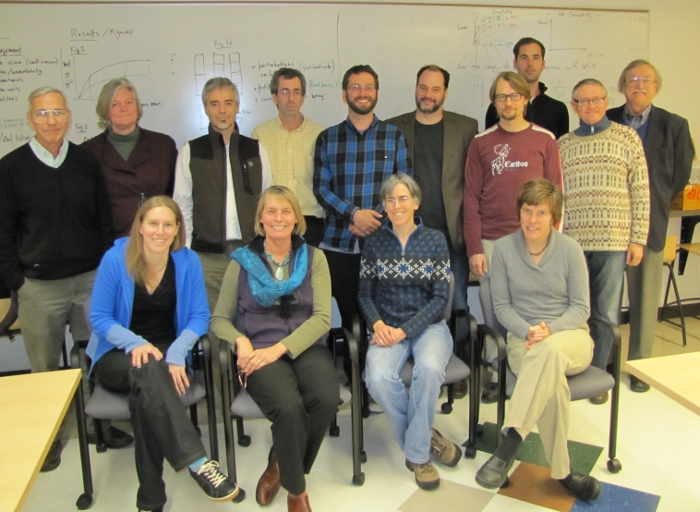 |
| Meeting 1 participants. (Back row, L to R): Chris Cosner, Yetta Jager, Miguel Araujo, Fred Adler, Will Godsoe, Nat Holland, Otso Ovaskainen, Michael Bode, Bruce Kendall, Robert Holt; (Seated, L to R): Jill Jankowski, Janet Franklin, Robin Snyder, Lauren Beth Buckley. Not pictured: Jane Elith |
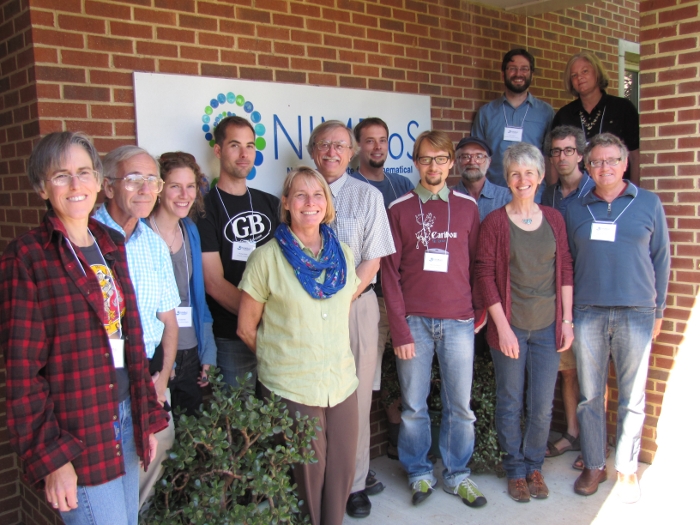 |
| Meeting 2 participants. (L to R): Robin Snyder, Chris Cosner, Jill Jankowski, Michael Bode, Janet Franklin, Robert Holt, Guillaume Blanchet, Otso Ovaskainen, Tony King, Jane Elith, Fred Adler, Bruce Kendall; (Back row): Will Godsoe, Yetta Jager; (Not Pictured): Lauren Beth Buckley |
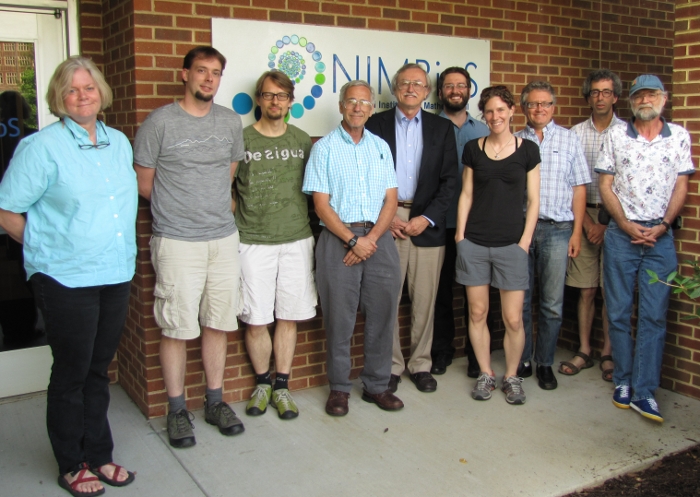 |
| Meeting 3 participants: (Back, L to R) Yetta Jager, Guillaume Blanchet, Otso Ovaskainen, Chris Cosner, Robert Holt, Will Godsoe, Jill Jankowski, Bruce Kendall, Fred Adler, Tony King |
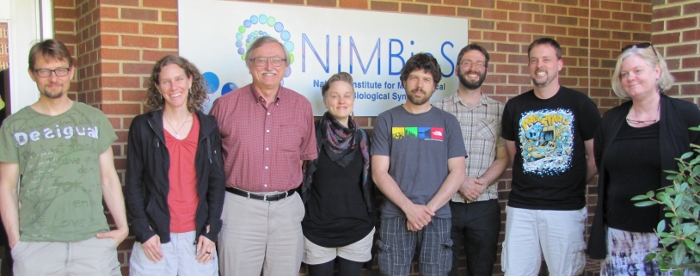 |
| Meeting 4 participants (L to R): Otso Ovaskainen, Jill Jankowski, Robert Holt, Anna Norberg, Dominique Gravel, Will Godsoe, Guillaume Blanchet, Yetta Jager. |
NIMBioS Working Groups are chosen to focus on major scientific questions at the interface between biology and mathematics. NIMBioS is particularly interested in questions that integrate diverse fields, require synthesis at multiple scales, and/or make use of or require development of new mathematical/computational approaches. NIMBioS Working Groups are relatively small (up to 10 participants), focus on a well-defined topic, and have well-defined goals and metrics of success. Working Groups will meet up to 3 times over a two-year period, with each meeting lasting up to 2.5 days.
A goal of NIMBioS is to enhance the cadre of researchers capable of interdisciplinary efforts across mathematics and biology. As part of this goal, NIMBioS is committed to promoting diversity in all its activities. Diversity is considered in all its aspects, social and scientific, including gender, ethnicity, scientific field, career stage, geography and type of home institution. Questions regarding diversity issues should be directed to diversity@nimbios.org. You can read more about our Diversity Plan on our NIMBioS Policies web page. The NIMBioS building is fully handicapped accessible.
NIMBioS
1122 Volunteer Blvd., Suite 106
University of Tennessee
Knoxville,
TN 37996-3410
PH: (865) 974-9334
FAX: (865) 974-9461
Contact NIMBioS


